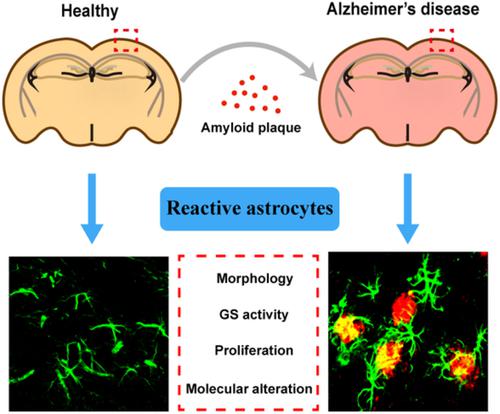Our official English website, www.x-mol.net, welcomes your
feedback! (Note: you will need to create a separate account there.)
Morphological and molecular alterations of reactive astrocytes without proliferation in cerebral cortex of an APP/PS1 transgenic mouse model and Alzheimer's patients.
Glia ( IF 5.4 ) Pub Date : 2020-05-29 , DOI: 10.1002/glia.23845 Kun-Yu Li 1 , Pi-Fang Gong 1 , Jia-Tong Li 1 , Nan-Jie Xu 2 , Song Qin 1
Glia ( IF 5.4 ) Pub Date : 2020-05-29 , DOI: 10.1002/glia.23845 Kun-Yu Li 1 , Pi-Fang Gong 1 , Jia-Tong Li 1 , Nan-Jie Xu 2 , Song Qin 1
Affiliation

|
Astrocytes are fundamental for maintaining brain homeostasis and are commonly involved in the progression of neurodegenerative diseases including Alzheimer's disease (AD). In response to injury or toxic material, astrocytes undergo activation that results in hypertrophy and process ramification. Although numerous studies have shown that reactive astrocytes are intimately related to the pathogenesis of AD, their characteristic features including morphological and molecular alterations that occur during different stages of AD progression remain to be elucidated. Here, we crossed astrocyte‐specific reporter mice hGFAP‐CreERT2;Rosa‐tdTomato with APP/PS1 mice, and then used genetic tracing to characterize the morphological profiles and expression of molecular biomarkers associated with progressive β‐amyloid deposits in the cortical region of AD mice. Expression of glutamine synthetase (GS) was lower in cortical reactive astrocytes, in contrast to the higher expression of glial fibrillary acidic protein, of APP/PS1 mice and AD patients relative to that in cortical astrocytes of wild‐type mice and age‐matched controls, respectively. GS activity was also decreased obviously in the cortex of APP/PS1 mice at 6 and 12 months of age relative to that in the wild‐type mice of the same ages. Furthermore, cortical reactive astrocytes in APP/PS1 mice and AD patients did not undergo proliferation. Finally, based on RNA‐sequencing analysis, we identified differentially expressed transcripts of signal transduction molecules involved in early induction of reactive astrocytes in the cortex of APP/PS1 mice. These findings provide a morphological and molecular basis with which to understand the function and mechanism of reactive astrocytes in the progression of AD.
中文翻译:

APP/PS1 转基因小鼠模型和阿尔茨海默病患者大脑皮层无增殖反应性星形胶质细胞的形态学和分子学改变。
星形胶质细胞是维持大脑稳态的基础,通常参与神经退行性疾病的进展,包括阿尔茨海默病 (AD)。作为对损伤或有毒物质的反应,星形胶质细胞经历激活,导致肥大和过程分支。尽管许多研究表明反应性星形胶质细胞与 AD 的发病机制密切相关,但它们的特征,包括在 AD 进展的不同阶段发生的形态和分子改变,仍有待阐明。在这里,我们将星形胶质细胞特异性报告小鼠hGFAP-CreERT2;Rosa-tdTomato与APP/PS1杂交小鼠,然后使用遗传追踪来表征与 AD 小鼠皮层区域中进行性 β-淀粉样蛋白沉积相关的分子生物标志物的形态特征和表达。与野生型小鼠和年龄匹配对照的皮质星形胶质细胞相比,APP/PS1小鼠和 AD 患者的皮质反应性星形胶质细胞中谷氨酰胺合成酶 (GS) 的表达较低,而胶质纤维酸性蛋白的表达较高, 分别。与同龄野生型小鼠相比,6 月龄和 12 月龄的APP/PS1小鼠皮层的 GS 活性也明显降低。此外,APP/PS1 中的皮质反应性星形胶质细胞小鼠和 AD 患者没有发生增殖。最后,基于 RNA 测序分析,我们鉴定了参与早期诱导APP/PS1小鼠皮层反应性星形胶质细胞的信号转导分子的差异表达转录本。这些发现为理解活性星形胶质细胞在 AD 进展中的功能和机制提供了形态学和分子学基础。
更新日期:2020-05-29
中文翻译:

APP/PS1 转基因小鼠模型和阿尔茨海默病患者大脑皮层无增殖反应性星形胶质细胞的形态学和分子学改变。
星形胶质细胞是维持大脑稳态的基础,通常参与神经退行性疾病的进展,包括阿尔茨海默病 (AD)。作为对损伤或有毒物质的反应,星形胶质细胞经历激活,导致肥大和过程分支。尽管许多研究表明反应性星形胶质细胞与 AD 的发病机制密切相关,但它们的特征,包括在 AD 进展的不同阶段发生的形态和分子改变,仍有待阐明。在这里,我们将星形胶质细胞特异性报告小鼠hGFAP-CreERT2;Rosa-tdTomato与APP/PS1杂交小鼠,然后使用遗传追踪来表征与 AD 小鼠皮层区域中进行性 β-淀粉样蛋白沉积相关的分子生物标志物的形态特征和表达。与野生型小鼠和年龄匹配对照的皮质星形胶质细胞相比,APP/PS1小鼠和 AD 患者的皮质反应性星形胶质细胞中谷氨酰胺合成酶 (GS) 的表达较低,而胶质纤维酸性蛋白的表达较高, 分别。与同龄野生型小鼠相比,6 月龄和 12 月龄的APP/PS1小鼠皮层的 GS 活性也明显降低。此外,APP/PS1 中的皮质反应性星形胶质细胞小鼠和 AD 患者没有发生增殖。最后,基于 RNA 测序分析,我们鉴定了参与早期诱导APP/PS1小鼠皮层反应性星形胶质细胞的信号转导分子的差异表达转录本。这些发现为理解活性星形胶质细胞在 AD 进展中的功能和机制提供了形态学和分子学基础。











































 京公网安备 11010802027423号
京公网安备 11010802027423号